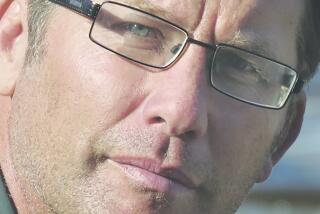Adamson Remembered : ‘Born Free’ Movement: The Work Goes On
- Share via
It wasn’t as if George Adamson, Kenya’s recently slain “Grand Old Man of the Bush,” didn’t know about the increasing dangers from poachers stalking wildlife. Adamson, whose success at returning rehabilitated lions to the wild inspired the film “Born Free,” had been repeatedly urged to leave the Kora National Reserve where he was murdered last week, according to Kim Ellis, one of the prime encouragers. A Los Angeles native who was visiting her parents in Brentwood at the time of Adamson’s death, Ellis has worked in Africa with Adamson and his colleague Tony Fitzjohn since 1985.
Packing to return to Africa as she talked, Ellis pointed out that attitudes toward conservationists in Kenya had become increasingly hostile. By 1980, the Kenya government, which once supported Adamson’s work, “could no longer accept his lion rehabilitation program--it was no longer a priority.”
But even so, Adamson, 83, steadfastly remained at Kora, monitoring the lions he had previously returned to the wild and working with three lions there in the last year. After his lion program officially ended, Adamson had helped to set up a nearby leopard rehabilitation project run by Tony Fitzjohn, his closest colleague for the last 18 years. But by 1986, the government had also “closed down” the leopard camp, Ellis lamented, and native herdsmen had begun moving into the reserve, burning acres of bush, bringing livestock into areas where lions and leopards freely roamed and poisoning those that got too close to their herds.
Thus, Adamson had urged Ellis and Fitzjohn to establish a new camp at a reserve on friendlier turf. And they did--the Mkomazi Game Reserve in Northern Tanzania, where the government declared the rehabilitation of wildlife to be a “priority national project.”
Adamson had not yet seen the group’s new, 1,300-square-mile reserve, said Ellis, but he had planned to move there with them when things at Kora became “intolerable.”
As for why he didn’t leave, she speculated that he felt his work was still at Kora, where both his late brother and some of his favorite lions were buried.
“Whether the government stopped protecting the land (at Kora) is hard to say. It just stopped working,” Ellis emphasized, adding that she’s not sure what will become of the reserve now that its leader is gone. “I don’t know if they’ll close it up. It depends on what the government decides.”
For the last nine months, Ellis has been in Southern California raising funds for the TonyFitzjohn/George Adamson African Wildlife Preservation Trust. She headed back to Africa Friday to attend Adamson’s funeral at Kora early this week and then to return to the camp in Tanzania.
On the bed in the elegant Brentwood home of her parents sat supplies that will allow her to continue to live and work in the bush. And, for company, there was a copy of Larry King’s autobiography and Wolfgang Puck’s “Modern French Cooking.”
While Adamson’s murderers were presumed to be Somali robbers and poachers by those who witnessed the incident, Ellis claimed that there was little point in comparing his death to that of gorilla researcher Dian Fossey or others thought to have been killed by poachers.
“George never did anything to antagonize people,” she said. “I think 99.9% of the people in the area adored George. He was the St. Francis of the animals there.”
While some have wondered why Adamson would continue driving toward a pickup truck that was being robbed by armed men, Ellis reasoned that Adamson undoubtedly presumed that those in the truck were visitors en route to his camp. But, before Adamson could help them, he and two members of his staff were gunned down by men wielding automatic rifles. One member of Adamson’s staff jumped out of the vehicle, survived and relayed the story to reporters.
“I don’t think he (Adamson) was foolhardy. There’s only one road there and what was he going to do? He was very brave. Was he supposed to back up and race back to camp, leaving those people endangered? I’m not surprised he did it. I think he was very brave doing it,” Ellis insisted. She noted that a standard procedure at Adamson’s Kora National Reserve was to drive the four miles from their camp to the airstrip after hearing the sounds of an airplane arriving.
In the four years that Ellis has spent with Adamson and Fitzjohn in the bush, the three had never directly encountered poachers.
“Often, we would come across poached elephants,” she recalled in a slight European accent, acquired from the time she spent studying in Europe and from living near Adamson, a native of India who grew up in England, and with Fitzjohn, who is from London. “But even when the nomadic herdsmen were there, George wouldn’t go over and curse them out.”
“There was nothing not to love (about Adamson),” remembered actress Ali MacGraw, who once stayed with Adamson and Fitzjohn at Kora and filmed a documentary about their work there. “George Adamson had a very powerful presence and commitment to the planet. . . . The way he and animals interacted spoke for itself. . . . My feeling about Tony and Kim is that they have enormous courage (to carry on Adamson’s work).”
Earlier this year, MacGraw became chairman of the Mkomazi Project, an endeavor Ellis and Fitzjohn will undertake to rehabilitate African wild dogs, cheetahs and other endangered species in northern Tanzania. Among other things, MacGraw narrated a documentary for the cause. And, at a May fund-raiser at Morton’s restaurant, she urged other celebrities and supporters of the project to donate funds.
More to Read
Sign up for Essential California
The most important California stories and recommendations in your inbox every morning.
You may occasionally receive promotional content from the Los Angeles Times.










